Cucumber hybrid “Beam splendor F1”: growing gherkins in a greenhouse, open ground and on a windowsill
To properly grow hybrids, you need to study their specifics. The article will focus on the hybrid Beam Splendor F1, bred by Ural breeders. You will learn the features of caring for it and how to use the resulting harvest.
Description of the hybrid
Beam splendor cucumbers are related to gherkins. They are grown in open ground, in greenhouses, and also on a windowsill in an ordinary pot.
Suitable for cultivation in Siberia and the Urals.
Distinctive features
The hybrid has a lot of advantages:
- resistance to temperature changes;
- the possibility of growing in low-lying areas with increased fog;
- resistance to more common cucumber diseases;
- fruiting until autumn even during frosts;
- high yield per bush.
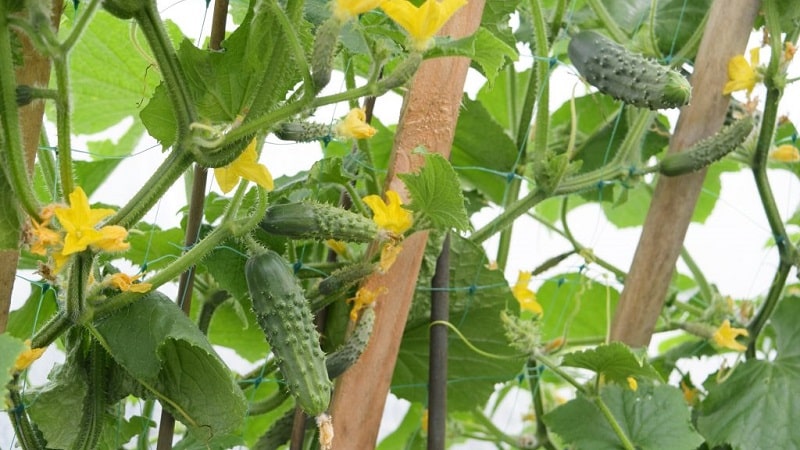
Composition, properties, benefits, calorie content
Composition of hybrid cucumbers Beam splendor F1: 95% water, carbohydrates, sugars, dietary fiber, ash, vitamins and minerals. Calorie content 14 kcal per 100 g. The fruits are sweet and juicy.
Fruit consumed fresh and canned. Due to the miniature size of gherkins and their taste, they are used mainly for preservation. The sizes of fruits from one bush are the same.
Due to the increased content of potassium in fruits note the benefits of fruits for the functioning of the heart and kidneys. Fresh consumption of cucumbers has a urinary and diaphoretic effect.
Fruit have a choleretic and mild laxative effect. Cucumber juice relieves fatigue of the eyelids: in case of redness and swelling, place cucumber slices on them or make lotions with its juice.
Hybrid characteristics
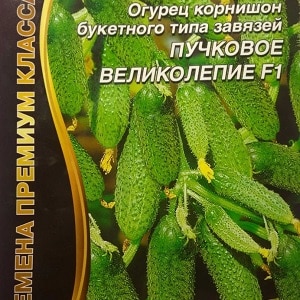 The yield of the cucumber Bunch splendor F1, declared by the manufacturers, reaches 40 kg from 1 bush. This is achieved due to the formation of a large number of fruits in 1 bunch: the number ranges from 3 to 7 ovaries at the same time.
The yield of the cucumber Bunch splendor F1, declared by the manufacturers, reaches 40 kg from 1 bush. This is achieved due to the formation of a large number of fruits in 1 bunch: the number ranges from 3 to 7 ovaries at the same time.
All ovaries located in 1 bunch are fruit-bearing, since they are female. Pollination does not require the participation of insects or humans; the flowers are self-pollinating. The hybrid was bred by Ural breeders for cultivation in the climatic conditions of the Urals and Siberia.
The hybrid also tolerates hot, arid climates easily.. But cucumbers of this type are finicky to care for and require timely watering, weeding and the application of mineral fertilizers. To obtain a rich harvest during the growth of the bush, it needs to be shaped and tied up.
The hybrid is classified as a cucumber gherkin type, so you should not expect large fruits. The length of the cucumber reaches no more than 11 cm.
Attention! Beam splendor is not used for growing for seeds, since only the first generation hybrid has perfect qualities.
How to grow your own
The crop is early ripening, harvest is planned for 45-50 days after planting the seeds. For planting in open or protected ground, there are two options: seeds or seedlings.
Planting by seeds and seedlings
If you decide to plant seeds in the ground, they need to be prepared.
For disinfection, use a solution of manganese or saline, in which the seeds are immersed for 30-40 minutes.To germinate, the seeds are placed on damp gauze, folded in half, and covered with the same piece. The prepared raw materials are placed in polyethylene for 2 days in a warm place, after which the sprouts can be seen.
Attention! Hybrid seed material often bears a mark indicating that the seeds have been disinfected at the factory. Such grains do not need to be disinfected.
With seedling method germinated seeds are planted in small containers. Plastic cups filled with nutritious soil will do. Make a hole in the ground 2-3 cm deep.
Cover the containers with film and wait for the first leaves. As soon as they have emerged, the protection is removed and watering and spraying begin. When full 3-4 leaves appear, you can plant the seedlings in the ground.
About other varieties and hybrids of cucumber:
Hybrid “Garland”, which will delight you with a rich harvest
Growing in stages and care
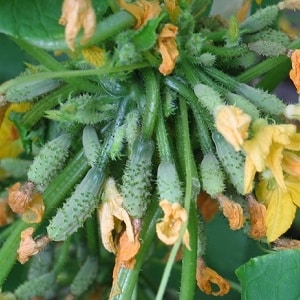 After planting the plants in the ground in a permanent place, regular care begins.
After planting the plants in the ground in a permanent place, regular care begins.
Form a bush starting from the moment the ovaries appear. First, in the lower 3-4 axils, shoots are removed along with the ovaries. Next, all shoots and lashes are constantly trimmed during the growth process.
Mineral and nitrogen fertilizers are applied every 2 weeks. The plant needs regular support throughout the entire fruiting period, since this is the most energy-consuming time for cucumbers. Each time you apply fertilizer, you need to water the cucumbers generously to enhance the effect.
Features of cultivation and possible difficulties
The most common difficulty in growing cucumbers Tufted splendor F1 - increased need for fertilizers. Before planting, 2/3 of the total volume of the allocated growing area is filled with mineral fertilizers.
In addition to applying a large amount of fertilizer in the period before planting, it is necessary to constantly add it during growth. However, even with such increased requirements of the hybrid, there is a risk of introducing excess nutrients.
Another difficulty concerns the formation of a bush and its garter. To tie the garter, the twine is fixed to a trellis and only then is it wrapped around the cucumber. It is best to cut the twine with a margin so that in the future it does not wrap around the bush too tightly.
Characteristic diseases and pests, resistance
cucumbers Beam splendor F1 protected from numerous diseases and pests at the genetic level. However, diseases are not 100% excluded. With high humidity in the summer, the hybrid can be affected by anthracnose, when the leaves become dry and the shoots become covered with ulcers.
White rot is another common disease inherent in the hybrid.. Starts with high humidity. The stem is affected by a mucous coating, the cucumbers become covered with white rot.
Has the same developmental features gray mold, but it occurs during sudden temperature changes. Since the hybrid is resistant to temperature changes, gray mold disease rarely occurs.
Among the insects, attacking the plant, we note aphids, whitefly and spider mites. They suck out the juices of the plant, slowing its growth and damaging the fruits. Pest control is standard - garlic and onion infusion, spraying with insecticides in case of severe infestation.
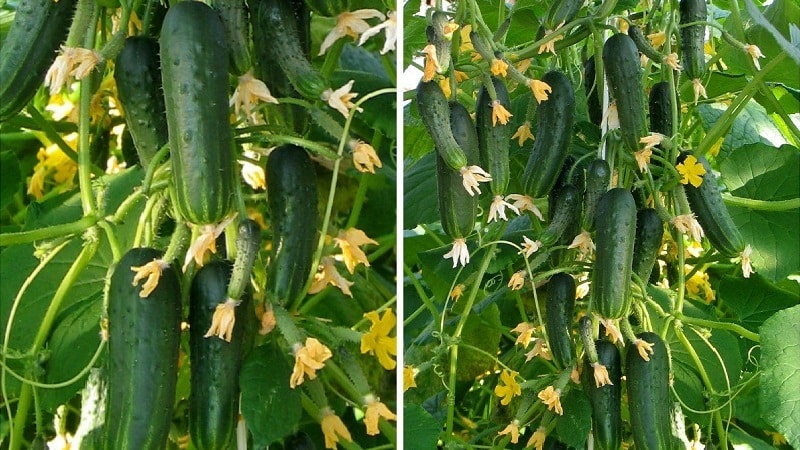
Harvesting and application
Beam splendor quickly produces a harvest even in places where cucumbers have already been harvested. Due to this feature, the bushes are harvested at least once every 2 days.
Use of fruits varies depending on preference. Sweetish in taste and juicy, cucumbers of this type are eaten fresh. The size and uniform shape of the fruits make them indispensable for canning and pickling.
Advantages and disadvantages
The hybrid has many advantages. Cucumbers are early, and harvesting can take until late autumn, especially in warm regions.
cucumbers have high yields and are protected from most known diseases. They have excellent taste and are good for preservation. They can be planted under any temperature conditions in open and closed ground.
The disadvantages include the need for frequent fertilizer in large quantities, which involves additional costs. Sometimes the disadvantages include frequent harvesting.
Reference! If the assembly schedule is not followed, the bush reduces fruiting rates, and the quality of the fruit deteriorates.
Consumer Reviews
The results of planting the hybrid Bunch Splendor vary among gardeners: the crop needs full care.
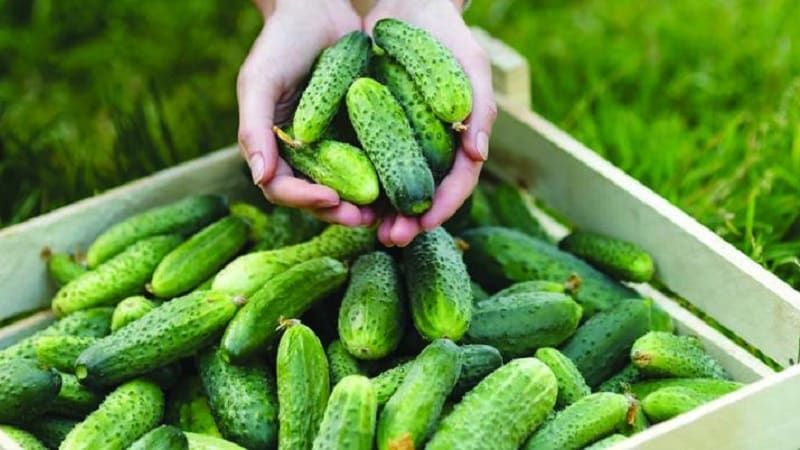
Antonina, Moscow: “I’ve been planting Tufted Splendor cucumbers for several years now. At first, a friend simply recommended them to me and sent me a photo of a large harvest. I purchased 2 bags of seeds for testing, followed the planting recommendations slightly incorrectly and did not germinate the seeds before planting. As a result, only 4 bushes grew from 8 seeds. I liked the yield and the taste, so next year I bought more and prepared more thoroughly. Now I pickle not only for my own people, but also for sale.”.
Olga, Rostov: “I tried to plant bunched cucumbers for the first time, so I immediately read all the recommendations on the Internet. Growing them is difficult due to the constant requirement of watering and fertilizers. As soon as I received the first harvest, I was happy, but I think that next season I will plant a little less, since there is nowhere to put them. I was pleased that the cucumbers appeared quickly; the first harvest was harvested at the beginning of summer.”.
Valentina, Belgorod: “Cucumbers of this type are not suitable for garden plantings, especially if you, like me, rarely go there. I planted several bushes, but only two grew. I applied fertilizers infrequently, and there was no time to monitor the harvest. The volume I received was quite small. This year I decided to plant seeds in my apartment on the balcony, let’s see what happens.”.
Conclusion
High-yielding cucumbers, Bunch Splendor, are great for gardeners who have the time and desire to monitor a demanding crop. The quality and appearance of grown gherkins will not leave housewives indifferent who appreciate crispy and smooth pickled or pickled cucumbers.